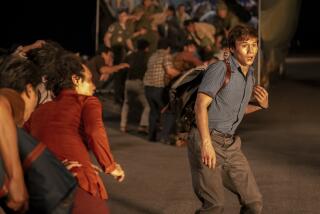Hope and Pain
- Share via
SANTA ANA — They don’t want to talk about it because talking means remembering. The starvation. The disappearance of loved ones. The deaths.
But in a week of conflicting news about the notorious Khmer Rouge leader responsible for Cambodia’s killing fields, some Cambodians can’t help but ask: Has Pol Pot really been captured?
“Please, I hope so. I want them to capture him and to kill him because Pol Pot killed a lot of people,” said Sivan Hok, a 54-year-old Santa Ana resident who watched her 5-year-old son, her mother, brother and sister die from the starvation brought about by the the Khmer Rouge. “I hear, yes, he has been captured, and I am happy. I hear, no, and I am mad again.”
So it is with many of the 4,000 Cambodian refugees in Orange County this week as news of Pol Pot’s capture, and a day later, that he remained on the run circulated around the Minnie Street area, the insular Cambodian neighborhood in Santa Ana.
Now living in the safety of their adopted country, Cambodians cannot forget that during Pol Pot’s control of their native land from 1975 to 1979, the Khmer Rouge killed about 1 million people, directly or indirectly, through executions, diseases and starvation brought about by the emptying of the cities and the forced collectivization of farms.
Pol Pot, who headed the regime, has been hiding in the country’s jungle since the Khmer Rouge were driven from power by the Vietnamese.
“I wish I know what the truth is, where Pol Pot is or if he has been caught,” said 36-year-old David Kann, a child care social worker who works as a volunteer in the Cambodian community.
Kann, of Santa Ana, has been surfing the Internet constantly this week for news. “I am interested about this because I was young [14] when I left Cambodia,” he said. “The older people, with strong memories, perhaps, they are interested in it too. But not too many can talk about it. It gives them too much pain.”
Bonna Irvai did not want to talk about Pol Pot at first. His name brings back the memory of that morning in 1975 when Khmer Rouge soldiers knocked on her door to drag away her crying 12-year-old sister, Ri Lee.
Irvai, 41 and a resident of Santa Ana, said she doesn’t know why Ri was taken away but assumed it was part of the Khmer Rouge’s movement to brainwash the country’s youth.
“I never heard from her again. I never knew what happened to her,” Irvai said Thursday. “I think she died. It was Pol Pot’s fault. He and the Khmer Rouge killed and killed.”
She and her husband, Heng Ling, like most of the country’s farmers, were forced into a collective farm, where they toiled from morning to night, planting rice and other vegetables.
Her husband lost six brothers and sisters to disease and starvation while they were imprisoned in the camp, she said. Khmer Rouge soldiers shot and killed a seventh brother.
“People died. Families torn apart. Pol Pot did this,” Irvai said. “I wish I know more English so I can talk of what he did. I hate him.”
Hok feels the same.
She recalls holding her 5-year-old son Sodasy as he died in his sleep. She watched him grow weaker and weaker from starvation, and thanked God for putting him out of his misery. She gave the same thanks when her mother, brother and sister died from hunger.
“After a while, I didn’t mind that they died because living was so painful,” Hok said.
“I will thank God again when Pol Pot dies.”
The reasons will be different this time.
More to Read
Sign up for Essential California
The most important California stories and recommendations in your inbox every morning.
You may occasionally receive promotional content from the Los Angeles Times.










